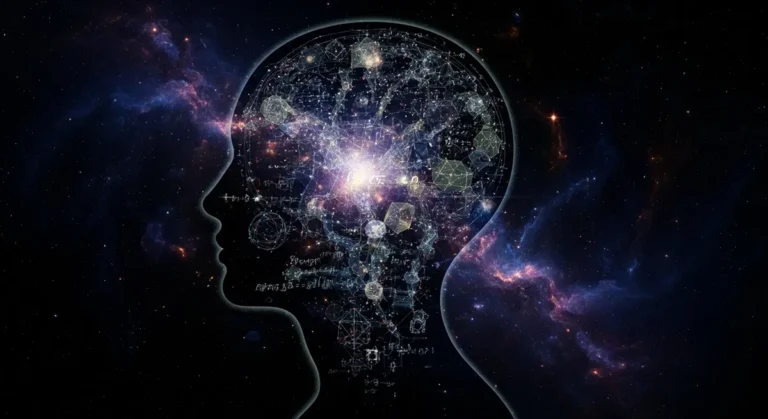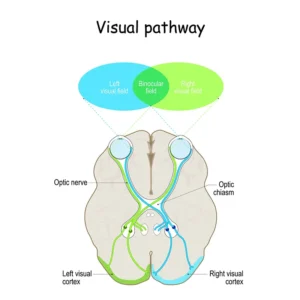Your Brain Sees Math: How Visual Intuition Powers Thought
Groundbreaking neuroscience reveals that our ability to understand math doesn't come from a special "logic" part of our brain, but by recycling the ancient visual systems we use to see and navigate the world.

Key Findings
- The brain does not use its language centers when processing high-level mathematical ideas.
- Math activates the same visuospatial brain networks used to perceive space, quantity, and even our fingers.
- The brain recycles these older, pre-existing circuits for the newer cultural invention of mathematics.
- A child's finger awareness is a better predictor of future math success than standard cognitive tests.
- This discovery challenges traditional teaching methods, supporting a more visual and intuitive approach to math education.
Primary Source
Source: Origins of the brain networks for advanced mathematics in expert mathematicians
Author(s): Marie Amalric & Stanislas Dehaene
Why does drawing a math problem often make it easier to solve? For centuries, we’ve been told that serious mathematics is a purely logical activity, separate from the messy, sensory world of sight and touch. But new evidence from neuroscience shows this is a myth. It turns out our brain’s ability to “see” is the secret superpower behind our ability to do math.1Seeing as Understanding: The Importance of Visual Mathematics for our Brain and Learning – Scholar Commons, accessed October 15, 2025, https://scholarcommons.scu.edu/cgi/viewcontent.cgi?article=1423&context=psych
How Does the Brain “See” Math?
For a long time, scientists debated where our math ability comes from. One idea was that it grew out of our language skills. Another was that it came from our ancient sense of number and space. Thanks to brain scanning technology, we now have a clear answer. Neuroscientist Stanislas Dehaene and his team scanned the brains of professional mathematicians.2Origins of the brain networks for advanced mathematics in expert mathematicians – PNAS, accessed October 15, 2025, https://www.pnas.org/doi/abs/10.1073/pnas.1603205113 They found something amazing.
When the mathematicians thought about complex math problems, the language parts of their brains stayed quiet.3On the role of visual experience in mathematical development: Evidence from blind mathematicians – PMC – PubMed Central, accessed October 15, 2025, https://pmc.ncbi.nlm.nih.gov/articles/PMC5833949/ Instead, a network of regions lit up. These were the exact same brain circuits that all people use for seeing shapes and understanding where things are in space. High-level math is not a new skill. It is an advanced use of our most basic visual and spatial intuition.

Our brain’s two visual pathways work together to do math. The “what” pathway (ventral stream) learns to recognize symbols like ‘7’, while the “where” pathway (dorsal stream) gives us an intuitive sense of its quantity and place in the world. Credit: Perkins School for the Blind.
Why Does the Brain Recycle its Parts?
The brain is a resourceful builder. When it needed to learn the new skill of mathematics, it did not create brand-new parts from scratch. Instead, it repurposed, or “recycled,” its existing tools. This idea is called neural reuse.4Neural reuse: a fundamental organizational principle of the brain, accessed October 15, 2025, https://pubmed.ncbi.nlm.nih.gov/20964882/ The brain took the circuits perfected over millions of years for navigating our world and recognizing objects. It then used them to build our ability to understand numbers and equations.
This explains why thinking with pictures feels so natural in math. We are tapping into some of the most powerful and highly optimized hardware in our brains. This connection is so deep that it even involves our fingers. The part of the brain that represents our fingers is active during calculations, even when we don’t consciously use them. In fact, one study found that a 6-year-old’s ability to sense their own fingers was a better predictor of their future math scores than standard tests.5Understanding the complexities of mathematical cognition: A multi …, accessed October 15, 2025, https://pmc.ncbi.nlm.nih.gov/articles/PMC10466984/
Why Does This Matter for Learning?
This discovery could change how we teach math forever. For decades, many classrooms have focused on memorizing rules and fast calculations. This approach often creates anxiety and the false idea that you are either a “math person” or you are not. But the science shows this is wrong. It suggests that a more visual and hands-on approach is better for how our brains actually work.6The Role of ‘Visual Mathematics’ in Brain Development and Learning | EdSurge News, accessed October 15, 2025, https://www.edsurge.com/news/2016-04-12-the-role-of-visual-mathematics-in-brain-development-and-learning
Studies show that when students are encouraged to draw problems and use visual tools, their understanding and performance improve dramatically.7Visual Math Improves Math Performance by Jo Boaler Stanford Professor of Mathematics Education, Online Course Experimenter, Y – NET, accessed October 15, 2025, https://padletuploads.blob.core.windows.net/prod/144585272/d892107b5ff26251663d6a344c5d4418/Visual%20Math%20Improves%20Math%20Performance.pdf It helps them see the structure of a problem, even if the final calculation is hard. By embracing visual math, we can make the subject more accessible and creative for everyone.
What If You Can’t Visualize?
Here is a fascinating puzzle. If math is so visual, how can people who cannot create mental pictures be good at it? This condition is called aphantasia, and it affects a small part of the population.8Aphantasia, Math and Me – MANGO Math Group, accessed October 15, 2025, https://www.mangomath.com/blog/aphantasia-math-and-me Surprisingly, many people with aphantasia excel in science and math. They use different strategies. Instead of seeing a shape in their mind’s eye, they understand its properties and relationships abstractly. One mathematician described it as knowing where everything is in a dark room without ever “seeing” it.9Aphantasiac mathematicians? – visualization – MathOverflow, accessed October 15, 2025, https://mathoverflow.net/questions/417159/aphantasiac-mathematicians
This tells us something crucial. The true foundation of math may not be mental pictures themselves. It is the brain’s deeper, non-linguistic ability to reason about space and relationships. Visuals are the most common path to this ability, but they are not the only one. This insight helps us understand the true, flexible nature of human intelligence.
